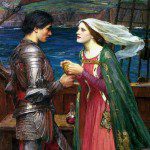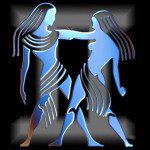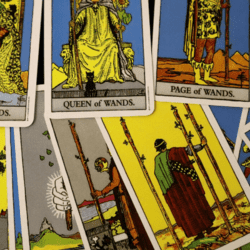Early humans depended upon nature for their very existence. This relationship only became more exacerbated as the first planters gambled their lives on the hope of coming rains. Consequently, their religious traditions revolved around forces of nature. Wouldn’t it be right, then, to say that early agriculturalists were naturalistic?
Hidden in this question is a false analogy between the concept of nature underpinning naturalism and that conceived by our Neolithic ancestors. There is little evidence to suggest the two are similar. In short, nature religion does not equal naturalism. The Neolithic does, however, suggest the possible development of a key prerequisite of naturalism.
This post is part of Naturalistic Traditions, a column exploring naturalism in Pagan ways. The present series explores the historical roots of naturalistic ways in order to gain an expanded sense of the historicity of the diverse styles of belief common in Paganism today. For previous posts in this series, see the index at the bottom.
The Neolithic of Neopagans
The Neolithic period, when humans in various parts of the globe first began to cultivate vegetable crops, exerts particular appeal for many Neopagans. Its Venus figurines and architecture like that at Çatalhöyük are tantalyzing. Stories are told of a female-centered, Goddess-worshipping golden age close to nature. It is an empowering narrative, depicting the current environmentally-destructive age of patriarchy as a mere hiccup in the history of our species.
Unfortunately, such theories have been discredited (e.g. Eller, 2000; Nelson, 2004), and many Neopagans now recognize the fact (e.g. ADF Druidry makes Eller’s critique a recommended text in their study program). The rise and fall of these theories can serve as an example of what not to do with naturalism: we must avoid projecting our modern concepts and values onto the past.
Nature in the Neolithic
As seen earlier in our investigation of modern cosmology, the nature referred to by the worldview of naturalism is typically characterized by impersonal physical laws. By contrast, the concept of nature in the Neolithic may have been quite different.
First, there need not have been any generalized concept of nature at all. Our modern fascination with general concepts is not necessarily characteristic of our species. For the most part, small-scale peoples tend to be more concerned with particular situations than general principles (Boyer, 2001; Evans- Pritchard, 1976; Keesing, 1982). Thus, even if early agricultural religions venerated specific natural forces like weather and fertility, it need not imply a notion of nature as such.
Second, veneration of the divine in specific natural phenomena doesn’t entail special respect for all instances of it. For example, even when goddesses are venerated, it does not usually correlate with enhanced status for women (Eller, 2000; Campbell, 1982; Tentori, 1982; Whyte, 1978). Though Venus figurines may have represented deity in the form of a woman, the status of Neolithic women may not have been correspondingly raised.* Likewise, deity in the form of a raincloud need not imply special respect for rainclouds themselves.
Finally, as discussed last time with regard to hunter-gatherers, certain aspects of human cognition make it unlikely that early peoples perceived natural events happening according to impersonal physical laws. More likely, early thought was personal and dualistic, perceiving an order of reality that was not law-like but malleable and open to persuasion.
Yet, despite the wide gulf that likely lies between the nature of naturalism and that of early agriculturalists, the Neolithic may have witnessed the development of something crucial to naturalism: the rise of widely-shared interpretations. This may be exemplified at the site of Çatalhöyük.
A new mode of religiosity at Çatalhöyük?
The Neolithic town of Çatalhöyük – a favorite among Neopagans, especially those hoping for a female-centered golden age – hails from roughly 9000 years ago (Ziflioğlu, 2008). It had a large population estimated conservatively at 3500-8000 people at any one time (Hodder, 2010). Using new archaeological techniques to review and expand excavations originally conducted by Mellaart, Ian Hodder discovered ten times as many figurines but only one of the famous Venus type (Balter, 2005). He sees little evidence of matriarchy or a mother goddess. Rather, he sees a “balance of power”:
When we look at what they eat and drink and at their social statues, we see that men and women had the same social status. There was a balance of power. Another example is the skulls found. If one’s social status was of high importance in Çatalhöyük, the body and head were separated after death. The number of female and male skulls found during the excavations is almost equal. (Ziflioğlu, 2008)
Meanwhile, Whitehouse and Hodder (2010) compare older and newer levels at the site and find evidence exemplifying a significant change related to modes of religiosity.
At the lower levels, representing older strata, there are signs of infrequent, emotionally-intense rituals associated with hunting, feasting, dancing, and burial of human remains. Bull horns adorn walls, wall paintings depict dangerous teasing and baiting of wild animals, and human remains lie buried beneath floors. Such is characteristic of a type of ritual found all over the world which Whitehouse calls imagistic. These rituals employ intensely-arousing stimuli to create a “flashbulb memory” in participants that they will remember and continue to interpret over the course of a lifetime (initiation rituals are a good example of this type). They are conducted rarely (Whitehouse and Hodder estimate burials at Çatalhöyük only once every ten years or so), and effectively bind small groups together through a shared experience. Most importantly, the experiential nature of the event gives rise to a multitude of interpretations as participants each reflect on their own unique experience. There is no uniform interpretation.
By contrast, the upper, newer strata at Çatalhöyük show fewer real bull horns (replaced instead by plaster horns), in-house burial largely ends, and stamp seals appear which suggest some kind of shared code. Uniform, site-wide practices emerge, such as the burning of houses after rituals of house abandonment. This evidence Whitehouse and Hodder interpret as indicative of the other type of ritual in Whitehouse’s binary scheme, a type which he calls doctrinal.* Such rituals are less intense but more frequent, and bond larger groups together (weekly church services are a modern example of this type). They enable a more elaborated and unified interpretation to spread through a population. No longer left to the ongoing exegetical process of the individual, interpretations of ritual events may become widely-shared. Extensive cross-cultural studies show that specific characteristics tend to cluster around these two ritual modes, and Whitehouse and Hodder think the scheme can be applied to the evidence at Çatalhöyük.
Their conclusion is nothing if not bold. Archaeologist Steven Mithen remains skeptical (Mithen, 2004). Indeed, the evidence at Çatalhöyük for the doctrinal type of ritual seems forced: I wonder if it could not as easily indicate a shift to some other kind of imagistic ritual that left fewer material traces. I also wonder if the theory might not find more fertile ground applied to megalithic monuments which seem to predict solar events, such as Stonehenge and Newgrange. These would seem to imply a widely-shared elaboration of some kind of order in the heavens. Finally, I wonder how the modes of religiosity theory would fare in other areas of early agriculture, such as India, East Asia, or the Americas.
If Whitehouse and Hodder are right about Çatalhöyük, it would be important to the history of naturalism: any worldview that is elaborated and widely-shared, such as naturalism***, needs at least some of the “doctrinal” element. The Neolithic presents some of the earliest known potential evidence for this new mode, which many other scholars withhold until after the invention of literacy.
So, were early agriculturalists naturalistic?
Due to differences in concepts about nature and natural events, it’s not likely that Neolithic planters were naturalistic. They may have engaged in nature religion, but that is not the same as naturalism. We must be careful not to project our modern notions onto the past, creating a mythic golden age of naturalism where there was none.
At the same time, the Neolithic may have contributed to the history of naturalism. A gradual shift from personal interpretations of ritual experiences to more centrally-established understandings may have paved the way for the development of widely-shared worldviews, including naturalism.
*Eller (2000) points to goddess worship in highly-patriarchal ancient Greece, and cites other authors as further support. Ena Campbell (1982), who found that veneration of the Virgin of Guadalupe is more popular among men than women in Mexico, is quoted by Eller as saying: “mother goddess worship seems to stand in inverse relationship with high secular female status.” A footnote references a similar finding by Tullio Tentori (1982) regarding Marian worship in Italy. Finally, the evidence drawn from Whyte is the most revealing. Comparing preindustrial societies, Whyte (1978) investigates “sex of gods and spirits”, “sex of mythical founders”, “sex of shamans”, “sex of witches”, and “religious ceremony participation”, and finds no correlation with women’s status. The only positive correlation with status is equally elaborate funerals for women and men.
*The word “doctrinal” is used here as a technical term from Whitehouse’s theory, and not as a synonym for “dogmatic.” Notably, according to Whitehouse’s classification, most Neopagan rituals would probably qualify as doctrinal, even though they appear imagistic compared to most Western world religions.
***I don’t mean to suggest that earlier peoples lacked a worldview, nor that ideas could not be widely-diffused before the emergence of Whitehouse’s “doctrinal” mode. Rather, I mean that a more or less uniform worldview, relatively independent of personal interpretation, is only likely to arise after it. Naturalism is a worldview negotiated by individuals yet constrained by a large body of facts; it is not simply open to interpretation. Nor does it rely primarily upon infrequent high-arousal experiences creating “flashbulb memories” that are later interpreted to yield one’s experiential understanding(s) of “naturalism”; rather, it depends heavily upon frequent study of scientific literature and the natural environment (which might be considered a kind of “ritual” fitting the “doctrinal” mode). This yields a consistent theoretical understanding. Moreover, I should add that the kind of worldview intended here is a conscious and reflective one. People also tend to have more implicit, non-reflective beliefs which may deviate from reflective views. These implicit beliefs arise as a result of evolved cognition, and tend to emerge whenever people do not or cannot take the time to reflect, such as when under cognitive load (Barrett, 2004). They appear to be a universal feature of human cognition, and are not what I refer to here by the term “worldview.”
References
Balter, M. (2005). The Goddess and the Bull. New York: Free Press.
Barrett, J. (2004). Why Would Anyone Believe in God? Lanham, MD: Altamira Press.
Boyer, P. (2001). Religion Explained: The Evolutionary Origins of Religious Thought. New York: Basic Books.
Campbell, E. (1982). “The Virgin of Guadalupe and the Female Self-image.” In: Preston, J. J., ed., Mother Worship, Chapel Hill: North Carolina University.
Evans-Pritchard, E. E. (1976). Witchcraft, Oracles, and Magic Among the Azande. Oxford: Oxford University Press.
Hodder, I. (2008-01-17). “A Journey to 9000 years ago”. Retrieved 2008-08-07.
Hodder, I. (2010). Religion in the Emergence of Civilization: Çatalhöyük as a Case Study. New York: Cambridge University Press.
Keesing, R. (1982). Kwaio Religion: The Living and the Dead in a Solomon Island Society. New York: Columbia University Press.
Mithen, S. (2004). “From Ohalo to Çatalhöyük: The Development of Religiosity during the Early Prehistory of Western Asia, 20,000-70,000 BC.” In: Whitehouse, H. and Martin, L. H. Theorizing Religions Past. Walnut Creek, CA: Altamira Press.
Nelson, S. M. (2004). Gender in archaeology: analyzing power and prestige. AltaMira Press.
Preston, J. J. (1982). Mother Worship: Themes and Variations. Chapel Hill, NC: North Carolina University Press.
Tentori, T. (1982). “An Italian Religious Feast.” In: Preston, J. J., ed., Mother Worship, Chapel Hill: North Carolina University.
Whitehouse, H. and Hodder, I. (2010). “Modes of Religiosity at Çatalhöyük.” In: Religion in the Emergence of Civilization, by Hodder, I., ed., New York: Cambridge.
Whyte, M. K. (1978). The Status of Women in Preindustrial Societies. Princeton: Princeton University Press.
Ziflioğlu, V. (2008, January 17). “A Journey to 9000 Years Ago.” Turkish Daily News. Retrieved May 12th, 2013, from: www.hurriyetdailynews.com.
















